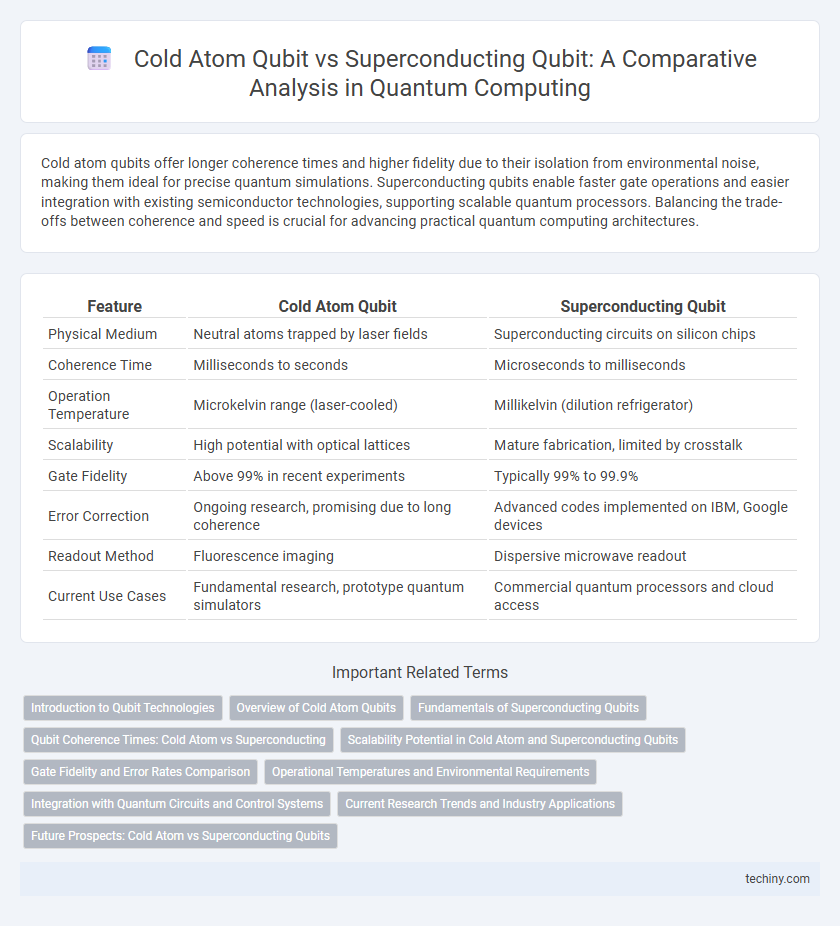Cold atom qubits offer longer coherence times and higher fidelity due to their isolation from environmental noise, making them ideal for precise quantum simulations. Superconducting qubits enable faster gate operations and easier integration with existing semiconductor technologies, supporting scalable quantum processors. Balancing the trade-offs between coherence and speed is crucial for advancing practical quantum computing architectures.
Table of Comparison
| Feature | Cold Atom Qubit | Superconducting Qubit |
|---|---|---|
| Physical Medium | Neutral atoms trapped by laser fields | Superconducting circuits on silicon chips |
| Coherence Time | Milliseconds to seconds | Microseconds to milliseconds |
| Operation Temperature | Microkelvin range (laser-cooled) | Millikelvin (dilution refrigerator) |
| Scalability | High potential with optical lattices | Mature fabrication, limited by crosstalk |
| Gate Fidelity | Above 99% in recent experiments | Typically 99% to 99.9% |
| Error Correction | Ongoing research, promising due to long coherence | Advanced codes implemented on IBM, Google devices |
| Readout Method | Fluorescence imaging | Dispersive microwave readout |
| Current Use Cases | Fundamental research, prototype quantum simulators | Commercial quantum processors and cloud access |
Introduction to Qubit Technologies
Cold atom qubits utilize ultra-cold atoms trapped by lasers to encode quantum information with high coherence times, benefiting from precise atomic control and minimal decoherence. Superconducting qubits, fabricated from Josephson junctions on silicon chips, offer fast gate speeds and scalability with established semiconductor manufacturing techniques. Both technologies target improved qubit fidelity and error rates to advance quantum computing architectures.
Overview of Cold Atom Qubits
Cold atom qubits utilize ultracold atoms trapped in optical lattices or magnetic traps to encode quantum information, offering long coherence times due to minimal interaction with the environment. These qubits benefit from precise manipulation using laser and microwave fields, enabling high-fidelity quantum gate operations. Compared to superconducting qubits, cold atom qubits exhibit superior scalability potential and reduced decoherence, making them promising candidates for fault-tolerant quantum computing.
Fundamentals of Superconducting Qubits
Superconducting qubits leverage Josephson junctions to create non-linear inductance, enabling discrete energy levels essential for quantum states. These qubits operate at milli-Kelvin temperatures to maintain coherence by minimizing thermal excitations and electromagnetic noise. The fundamental mechanism involves supercurrents tunneling through insulating barriers, establishing controllable quantum circuits critical for scalable quantum processors.
Qubit Coherence Times: Cold Atom vs Superconducting
Cold atom qubits exhibit coherence times ranging from several milliseconds to seconds, significantly surpassing superconducting qubits, which typically maintain coherence for 20 to 100 microseconds. The extended coherence in cold atom systems stems from their isolation in ultra-high vacuum and minimal interaction with environmental noise. Superconducting qubits benefit from rapid gate speeds but face challenges in coherence preservation due to material defects and electromagnetic interference.
Scalability Potential in Cold Atom and Superconducting Qubits
Cold atom qubits exhibit high scalability potential due to their ability to trap and manipulate thousands of atoms in optical lattices, enabling large qubit arrays with relatively low cross-talk. Superconducting qubits benefit from mature fabrication techniques and integration with existing semiconductor technologies, allowing for rapid scaling, though they face challenges such as increased error rates and crosstalk at higher qubit counts. Cold atom systems offer longer coherence times and uniform qubit properties, which contribute to more predictable scaling behavior in quantum processors.
Gate Fidelity and Error Rates Comparison
Cold atom qubits demonstrate gate fidelities exceeding 99.5%, leveraging long coherence times and precise laser control, which results in notably lower error rates compared to many superconducting qubit architectures. Superconducting qubits typically achieve gate fidelities around 99%, though they face higher error rates due to shorter coherence times and sensitivity to fabrication imperfections. The difference in error rates is critical for scaling quantum processors, with cold atom qubits offering improved stability for fault-tolerant quantum computing applications.
Operational Temperatures and Environmental Requirements
Cold atom qubits operate near absolute zero temperatures, typically in the microkelvin range, using laser cooling and magnetic traps to isolate atoms from environmental noise, thus achieving low decoherence rates. Superconducting qubits function at millikelvin temperatures within dilution refrigerators, requiring complex cryogenic systems to maintain superconductivity and minimize thermal fluctuations. The stringent thermal management for superconducting qubits contrasts with the ultra-high vacuum and laser stabilization demands of cold atom systems, impacting scalability and operational stability.
Integration with Quantum Circuits and Control Systems
Cold atom qubits leverage ultra-cold atoms manipulated by lasers and magnetic fields, offering long coherence times and high-fidelity operations essential for integration with quantum circuits and control systems. Superconducting qubits, fabricated using established semiconductor techniques, enable dense on-chip integration and rapid control via microwave pulses, providing scalability advantages in complex quantum processors. Both systems demand precise synchronization and error correction protocols, but cold atom platforms excel in coherence, whereas superconducting circuits benefit from mature fabrication and electronic control infrastructure.
Current Research Trends and Industry Applications
Cold atom qubits leverage ultra-cold temperatures to achieve long coherence times and high-fidelity quantum operations, making them ideal for precision sensing and quantum simulation in current research. Superconducting qubits benefit from established fabrication techniques and rapid gate speeds, driving advancements in quantum processors for commercial applications by companies like IBM and Google. Industry trends show hybrid approaches combining cold atom stability with superconducting circuit scalability to enhance error correction and qubit connectivity.
Future Prospects: Cold Atom vs Superconducting Qubits
Cold atom qubits offer exceptional coherence times and scalability potential through precise atomic control in optical lattices, positioning them as strong candidates for fault-tolerant quantum computing architectures. Superconducting qubits benefit from mature fabrication techniques and rapid gate operations, enabling near-term quantum processors but facing challenges in coherence and scalability. Future quantum technologies may integrate cold atom qubits for robust error correction with superconducting circuits to leverage fast processing speeds, driving hybrid quantum computing systems.
cold atom qubit vs superconducting qubit Infographic

 techiny.com
techiny.com